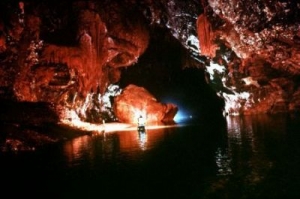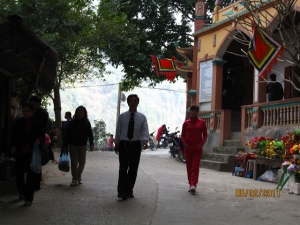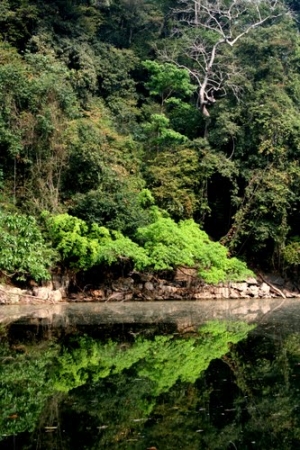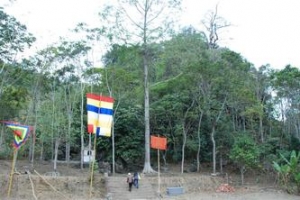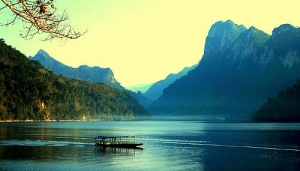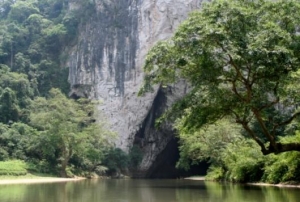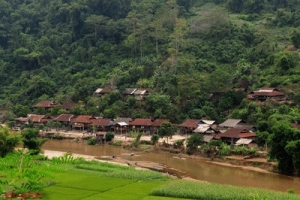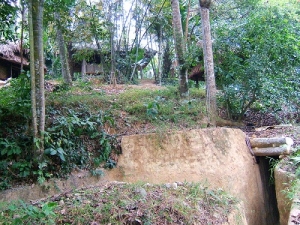
Asia Pacific Travel Team
Nang Tien Grotto (Fairy Grotto)
Fairy Grotto is a beautiful natural spot locating at the Phja Trang mountain range be- longing to Luong Ha commune, Na Ri district, Bac Kan Province.
The grotto is 5 km far from Yen Lac town. Fairy Grotto has appeared naturally for a long time. Legend says that once upon a time there were 7 fairies landing at the foot of Phja Trang Mountain to swim. They enjoyed so much that they did not know that the night came. They could no longer fly back to the heaven. God created a grotto for them to reside. Since then, the grotto has been called "Fairy Grotto". On 13 September 1999, the Ministry of Culture and Information signed decision on recognizing the Grotto as beauty spot at national level.
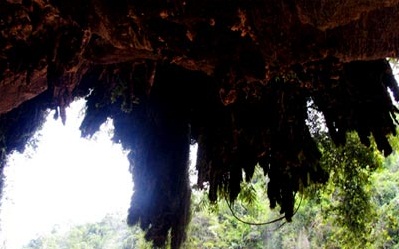
Coming to Phja Trang Mountain, tourists in Vietnam travel can take a rest in the Fairy Grotto, and enjoy the fresh air atmosphere.
Tham Temple to Worship a Brave Woman
Tham Temple is 600 meters northwest of Cho Moi town. The temple bases on the foot of Quan Thung Mountain. The temple worships a woman general named Tham, who tremendously contributed to the war against Co Den enemy in the second half of the 19th century? The temple complex consists of main temple, Co Tham (Ms Tham) shrine and Son Than (mountain god) shrine. The temple has three rooms. Previously, the temple worshipped Son Than and Thuy Than (water-nymph). The temple was not repaired until the second half of the 19th century.
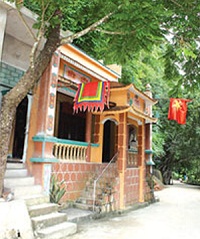 It is said that in the old days there was a beautiful girl who is a daughter of a poor fisherman. Her name was Tham. All young men in the region loved and wanted to get married with her. Unfortunately, a wicked feudal lord used his power to force her to become his wife. The lord was a henchman of the enemy. Ms Tham managed to get out of his house and called on a team of poor people to struggle against the enemy. Upon knowing that Ms Tham became a woman general, the feudal lord took enemy troops to fight her. A bloody batter occurred at the junction of Trang Co River. Ms Tham bravely directed her troop. Unfortunately, Ms Tham died by a toxic arrow. To commemorate a brave woman general, native peoples built a temple on the floor of her house to worship her. Since then, the temple has been called Tham.
It is said that in the old days there was a beautiful girl who is a daughter of a poor fisherman. Her name was Tham. All young men in the region loved and wanted to get married with her. Unfortunately, a wicked feudal lord used his power to force her to become his wife. The lord was a henchman of the enemy. Ms Tham managed to get out of his house and called on a team of poor people to struggle against the enemy. Upon knowing that Ms Tham became a woman general, the feudal lord took enemy troops to fight her. A bloody batter occurred at the junction of Trang Co River. Ms Tham bravely directed her troop. Unfortunately, Ms Tham died by a toxic arrow. To commemorate a brave woman general, native peoples built a temple on the floor of her house to worship her. Since then, the temple has been called Tham.
On early days of the spring, Tham Temple opens a festival starting on the sixth of January on lunar calendar and closing on the sixth of April on lunar calendar. The festival attracts a large number of visitors.
Ao Tien (The Fairy Pond)-Bac Kan Vietnam
Ao Tien is a small pond with the total width of about 3 hectares. The pond locates at the middle of Limestone Mountain and it is surrounded by green trees. Water of the pond is always clear.
Sitting on the bank of the pond, tourists in Vietnam travel can see fishes and shrimps swimming. On brushwood, monkeys are lying. The pond is also surrounded with primary forests. On rainy days, water in the pond has brown and muddy, leading to change water of Ba Be Lake. Ao Tien impresses tourists by its unique secret beauty. Climate there is very cool and temperate.
Joining tours in Vietnam and coming to Ao Tien, visitors are often well impressed by its unique secret beauty.
Thach Long Pagoda or Stone Dragon Pagoda
Thach Long Pagoda (or Stone Dragon) locates inside a large stone grotto of Thach Long Mountain lying parallel with High Way 3. Driving from Bac Kan city to Thai Nguyen for 19-20 kilometers, tourists in Vietnam travel will see the gate of Thach Long Pagoda on the right.
No one can know when the pagoda began worshipping Buddha, Saint and the Holy Mother. Elders say that it has been for a long time when the people of Vi Huong commune took statues to their pagoda called Hoa Son, they found a beautiful natural grotto inside Thach Long Mountain. They immediately took the statutes to the grotto and worshipped them here. Yet not until the 19th century, Thach Long Pagoda was officially worshipped by the people. Because the pagoda has special structure and it is also a secrete place, the Ly Dynasty selected the pagoda as a fortress to defeat the Tong enemy.
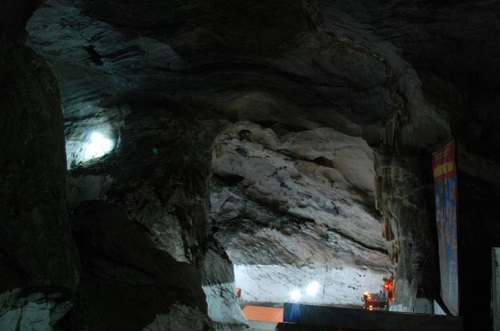
In the war against French colonialism, the pagoda became a weapon producing place and storage and the people stopped worshipping the pagoda. In 1949-1950, Great President Ho Chi Minh visited the pagoda three times and in 1950 he stayed here for one night. In 1954, the pagoda became the Bac Thai Weapon Transport Station. Peace was re-established, the pagoda was given back to the locality and native people re-established the pagoda.
Ba Be National Park- A Precious Natural Heritage of Vietnam
Ba Be National Park is located 250 km away from Hanoi and 70 km away from Bac Kan's center. It belongs to Ba Be district in Bac Kan province. Covering an area of 23,240 ha, the national park is home to 417 types of flora and 299 types of fauna. There are a plenty of precious and endangered species that inhabit in this region.
Tourists in Vietnam travel who come to Ba Be not only enjoy the charisma of nature but also get to know many traditional and scientific values of this natural park through the helpful and energetic tour guides. In sunny days, the scenery resembles a Feng Shui painting that mesmerizes even the most demanding visitors. The surface of the lake is flat; it transforms the whole lake into a mirror that reflects the figures of the majestic mountains and the shining cloud.
Romantically, the young Tay girls in black outfits stand on different boats, helping travelers to cross the picturesque Ba Be Lake. Without a doubt, they are the knowledgeable amateur travel guides who continuously surprise you in your journey to explore this beautiful land. You will be also amazed to learn about the lives of the ethnic groups: their culture, their routine life, their myths, their traditions, etc. People are extremely hospitable in Ba Be so you can even have a chance to visit their house and experience for yourself the breath of Ba Be’s mountains and forests.

The park is a complex including lakes, rivers, streams, forests, and caves. Mother Nature loves it too much that she decides to give Ba Be a warm weather in winter and a cool weather in summer so that it can become an ideal destination for people from everywhere to come, admire and cherish in just any season.
The national park is really an inviting environment to relax and enjoy nature. It's special limestone landscape which is dotted with small villages of different ethnic groups that creates a charming vista of both human and natural beauty.
Obviously, Ba Be National Park displays an impressive amount of evidence of ecological condition. If tourists joining tours in Vietnam want to increase their knowledge of the geology, geomorphology of the region, this national park should be visited.
Visit Puong Cave in Ba Be National Park
Puong Cave (Động Puông) - a large cave with 30m high, 300m long, is an interesting place in Ba Be National Park that tourists in Vietnam travel should visit.
Puong Cave located on the Nang River, 5km from the town of Ba Be District, Bac Kan province, was created by the rivers current as it flowed next to the base of the Lung Nham Mountain, which is a chain of Limestone Mountains.
Looking into the cave, you will see that it is inhabited by a population of thousand of bats belonging to 18 species. After exploring the cave, you will note that Nang River flows at the foot of the limestone mountain, goes through Puong Cave to reach Ba Be Lake and consists of a series of spectacular cascades between perpendicular walls of rock.
Pac Ngoi Village Lures Tourists by its Traditional Stilt Houses
Situated in Bac Kan province, Pac Ngoi Village has more than 40 traditional stilt houses locating on the slope of mountains which surround Ba Be Lake, emphasizing the beauty of this famous eco-tourism destination.
Surprisingly, while the traditional stilt houses have almost been eradicated in many other provinces, the antique, unique and original houses of ethnic groups are still highly valued and preserved in Pac Ngoi despite the presence of modern architecture.
According to the local government, it is not the lack of money that keeps the inhabitants from building new and convenient houses but the love for their ethnic heritage. They strive to preserve and protect those cultural values from disappearing forever, because without these beautiful stilt houses, Pac Ngoi Village is no longer Pac Ngoi village.
Tourists in Vietnam travel coming to Pac Ngoi are not only entitled to witness with their naked eyes the most wonderful scenery of Northern Vietnam: a plethora of austere yet interesting stilt houses blending themselves with the glimmering mist and the shinning Ba Be Lakes, but also to stay in the rhythm of the Tay culture.
This claim can be easily proven by the fact that visitors joining tours in Vietnam have to remove their shoes once they step the very first steps on the staircase of a stilt house. Inside the house, ethnic people gather around the gleaming fireplace, forgetting themselves in the sophisticate stories about the economy or the politic.
They create a world that shares nothing in common with the big cities where electronic lights and high buildings are ubiquitous. They are just there, in their beautiful social center, waiting to share their most interesting stories about life with you.
The Relics of ATK Bac Kan
ATK is located in Bang Lung Townlet, Cho Don District, Bac Kan Province. It consists of a complex of underground tunnels and rooms emboldened by a missile defense system in Cho Don. This unique and invincible complex was one of the most important venues of the Vietnam Army from 1946 to 1954, where President Ho Chi Minh and many other leaders gathered, discussed and made vital decision involving the destiny of the nation.

In the long and unending war against the French's colonization, Cho Don was chosen to be the Safe Zone of the revolution. Since then, this land had welcomed and protected many Central Departments, as well as the most influential leaders of the Communist Party of Vietnam. In the time between 1947 and 1952, almost all of the Central Departments had their headquarters in Cho Don. As a result, the underground tunnels were built in order to protect the prominent leaders and officers. Deep down under the ground, a whole complicated system of paths, tunnels, rooms were created. he whole construction was covered with a defense system that is able to withstand bombs and bullets of the enemy.
Coming to ATK in particular and Cho Don in general, tourists in Vietnam travel can not only visit many historical sites but also learn more about the lives of the local inhabitants, discovering their most beautiful cultural essences which can only be found there.
Introducing Ba Be National Park
It really is a babe: a beautiful region that covers more than 7000 hectares and boasts mountains high, rivers deep, waterfalls, plunging valleys, lakes and caves set amid towering peaks. The surrounding area is home to members of the Tay minority, who live in stilt homes.
The park is a tropical-rainforest area with over 550 named plant species, and the government subsidises the villagers not to cut down the trees. The 300 or so wildlife species in the forest include 65 (mostly rarely seen) mammals, 214 bird species, butterflies and other insects. Hunting is forbidden, but villagers are permitted to fish.
The park is surrounded by steep mountains, up to 1554m in height. The 1939 Madrolle Guide to Indochina suggests travelling around Ba Be Lakes ‘in a car, on horseback, or, for ladies, in a chair’, meaning, of course, a sedan chair.
Ba Be (Three Bays) is in fact three linked lakes, which have a total length of 8km and a width of about 400m. The deepest point in the lakes is 35m, and there are nearly 50 species of freshwater fish.
Two of the lakes are separated by a 100m-wide strip of water called Be Kam, sandwiched between high walls of chalk rock. The Thac Dau Dang (Dau Dang or Ta Ken Waterfall) consists of a series of spectacular cascades between sheer walls of rock, and is accessible by boat and on foot during day trips. Just 200m below the rapids is a small Tay village called Hua Tang. It costs 400, 000d for a boat here and takes at least four hours.
Hang Puong (Puong Cave) is visited on day tours. It’s about 30m high and 300m long, and completely passes through a mountain. A navigable river flows through the cave, making for an interesting boat trip. It costs 300, 000d for a boat and takes three hours.
Renting a boat is de rigueur, and costs from 150, 000d per hour. The boats can carry about 12 people (but it’s the same price if there are just two), and you should allow at least seven hours to take in most sights. Enjoy the ride: it’s lovely despite the noisy engines. An optional guide, worth considering, costs US$10 per day. The boat dock is about 2km from park headquarters.
The park staff can organise several tours. Costs depend on the number of people, but expect to pay at least US$25 per day if you’re travelling alone. There’s the option of a one-day tour by boat; a one-day tour combining motorboat, a 3km or 4km walk, and a trip by dugout canoe; and there are also combination cycling, boating and walking possibilities. Homestays can be arranged at several of the villages in the park, and longer treks can also be arranged.
The park entrance fee is payable at a checkpoint on the road into the park, about 15km before the park headquarters, just beyond the town of Cho Ra.
Ba Be Lake – a haven of serenity
After departing from the capital city, the passenger car took me to Bac Kan Town on Road 3. Viewing the passing hamlets in the car, I was sunk in divergent legends of Ba Be Lake. One legend says that this area used to be a very large valley sheltering the Nam Mau Village. Each year, the villagers gathered to hold an offering ceremony for Buddha. One year, a leprous old woman came to the ceremony but was neglected and asked to keep away from the others. Luckily, a widow welcomed her and gave her food. The old woman, who later turned out to be a fairy mother, paid respect by granting the widow a handful of ash and a seed of rice. The next day a monsoon overwhelmed the valley but the hoof the widow was somehow raised above the water line and protected. Following the fairy mother’s words, the widow scattered the handful of ash around the hoand water could not flow into her house; she threw the cover of the rice seed into the water, and it turned into a dug-out canoe which helped her float. After that, the flooded valley turned into three lakes which today form Ba Be Lake. Ba Be, meaning three lakes, was created by the confluence of river tributaries Pe Lam, Pe Lu and Pe Leng (Pe means Lake in Tay language) after earthquakes tens of millions of years ago.
Passing through the reed grasses, downstream from the serene Nang River, I saw many dug-out canoes like the kind mentioned in the legend. For local people living along the Nang River and Ba Be Lake, they are popular means of transportation. A dug-out canoe looks like the cover of rice seed. It's dedicated and long. It can glide fast and even downstream without energy-consumption, and it never leaks. Dug-out canoes are indispensable when people want to catch small fish in the lake.
The canoe drifts through the bends of the river and past scenic high cliffs through Lung Nham Mountain to reach Puong Cave. Inside the cave with the poor light there exist many stalactites in different shapes overhead. Ba Be Lake is surrounded by many ancient trees, from which several varieties of precious wood are obtained. Up to 30 animal species such as wild pigs, bears, panthers, monkeys, and birds inhabit the area. Scenic high limestone cliffs around the lake with the height of several thousands of meters look like skyscrapers amidst the city. Along the two riverbanks lie many hamlets of the Tay, Red Dao and White H’mong ethnic minorities.
Riverside trees swayed in the wind to welcome me back to the crossroads between the Nang River and the way to Ba Be. I turned right into the tributary of light blue water and then headed for Ba Be Lake which is 4km from the cave. The 8km long and 3km wide lake covers an area of 650 hectares. According to scientific research, Ba Be Lake was formed approximately 200 million years ago due to geological constitution. The lake, located 145m above sea level, is surrounded by limestone cliffs. This biodiversity reservoir is the habitat for fauna and flora thousands of years old. The surface of the lake is so tranquil that people can see even see the lake bed. It is home to 106 fish species and is surrounded by many ancient trees.
After having taken a tour around the lake, I went to visit a temple on An Ma Island to offer incense. On the way back, I stopped to enjoy wine and fried fishes made by local women at a tent at the Ba Be lakeside. With its original and unspoiled landscape, Ba Be still offers a haven of peace and tranquility away from the bustle of city life. In addition to the river and lake tour, visitors can trek to local villages where Tay and Mong peoples live and keep their traditions.
Further information:
Ba Be Lake is nearly 300km from Hanoi and 50km from Bac Kan municipality. From Hanoi, you can drive motor or take passenger car to Bac Kan. Upon arriving in Bac Kan, drive further 35km to reach Ra market, turn left onto National Highway 279, then travel another 10km to arrive at Ba Be Lake.
Tourists can stay at guest building of Ba Be National Park which is price at 200,000/2 persons per room; or stay at stilt hoof Tay ethnic minority in Pac Ngoi and Po Lu hamlet with the price of VND15,000-20,000/person.
Famous specialty here is fish hot-pot, fried fish, roast chicken and goat meat enjoying with local sticky rice. Tourists will have the opportunity to take part in many folk games performed by local artists. In addition, visitors will have an unforgettable stay in the mountains by the lakes, enjoying sightseeing boat trips, hikes, water sports, and discovering the traditional customs of different ethnic minorities in the region.


